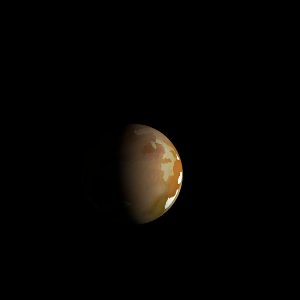|
|
Space Astro
|
Info for exoplanet "Jotron Keobe"
| Scientific (actual) data |
|---|
| Planet | Kepler-1246 b |
| Planet status | Confirmed |
| Radius | 0.121 |
| Orbital period | 11.3227 |
| Discovered | 2016 |
| Updated | 2021-02-05 |
| Tconj | 2454970 |
| Publication | Announced on a website |
| Detection type | Primary Transit |
| Alternate names | 2MASS J19103777+4858557 b, K02460.01, KIC 11236244 b, KOI-2460 b, KOI-2460.01, WISE J191037.74+485855.8 b |
| Star name | Kepler-1246 |
| Right ascension | 287.66° |
| Declination | 48.98° |
| Mag j | 13.286 |
| Mag h | 12.686 |
| Mag k | 12.59 |
| Star distance | 435 |
| Star metallicity | -0.03 |
| Star mass | 0.73 |
| Star radius | 0.69 |
| Star age | 3.89 |
| Star temperature | 4611 |
| Star alternate names | 2MASS J19103777+4858557, KIC 11236244, KOI-2460, WISE J191037.74+485855.8 |
| Wikipedia article | Kepler-1246 b |
Back
| |
| Fictional info (?) |
|---|
| Suggested name | Jotron Keobe |
| Planet type | Cold planet |
| Jotron Keobe is a terrestrial planet with a thin atmosphere, having surface features reminiscent both of the impact craters of the Moon and the valleys, deserts, and polar ice caps of Earth. Jotron Keobe is orbiting Kepler-1246 every 11 Earth days.
Jotron Keobe has been known to astronomers since the beginning of the space age. This planet is named after the deity Jotron Keobe, the spirit of chaos.
There are ongoing investigations assessing the past habitability potential of Jotron Keobe, as well as the possibility of extant life.
Optical ground-based telescopes are typically limited to resolving features about 225 kilometers across when Jotron Keobe is closest because of Earth's atmosphere. |
| Atmosphere | Carbonyl sulfide | 50% |
| Oxygen | 28% |
| Ozone | 15% |
| Methane | 5.2% |
| Argon | 0.89% |
| Water vapor | 0.59% |
| Hydrogen peroxide | 0.2% |
| Nitrogen | 0.0093% |
| Atmospheric pressure | 0.13 bar |
 |
| No known satellites |
| Google search for Jotron keobe |
|
Website by Joachim Michaelis
|
|
|
|